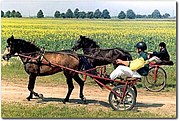Sulky
From Wikipedia, the free encyclopedia
A sulky is a lightweight cart having two wheels and a seat for the driver only but usually without a body. It was pulled by horses or dogs, and is used for harness races. The term is also used for a light stroller, an arch mounted on wheels or crawler tracks and used in logging, or other types of vehicle having wheels and usually a seat for the driver, such as a plough, lister or cultivator.
Contents |
[edit] Horse sulky
A sulky for horses is a lightweight two-wheeled, single-seat racing cart that is used as a form of rural transport in many parts of the world, and in most forms of harness racing in the United States, Australia, Canada and New Zealand, including both trotting and pacing races. They are called "sulkies" because of the solitary confinement of the driver (see, for example, "The Encyclopaedia of Driving" 1979, by Sallie Walrond). Race sulkies come in two categories,
- Traditional symmetrical sulkies
- Asymmetric or "offset" sulkies
The asymmetric sulky was patented in Australia in the 1980s and came to prominence in 1987 when a two-year-old gelding named Rowleyalla used one to break the then world record for his category by a colossal seventeen times the biggest previous margin that any southern hemisphere horse had ever broken a world mile record. At 3.4 seconds under the existing mark, it was also the greatest margin by which any world harness racing record was broken in that year.
In 1990 the asymmetric sulky was introduced into North America, winning seven of its first nine starts at Freehold, NJ. Today the great majority of sulky manufacturers in North America are producing asymmetric sulkies.
An additional sulky type is the "team-to-pole" or "pairs" sulky, a lightweight single seat sulky designed for draft by two horses abreast.
These may also be split into two types:
- Traditional pole and yoke with draft by traces.
- Dorsal hitch with draft direct from the saddle to the yoke and, via the pole, to the sulky.
Of the two, the dorsal hitch pairs sulky is the most recent, holding all current world pairs speed records over the mile to July 31, 2005.
[edit] Sulkies used in harness racing
There are two types of sulkies used in harness racing.
- Jog Carts, used only for training, are bigger and bulkier than a racing bike. The shafts are normally made out of wood, but may be aluminum, steel or stainless steel. They have bigger seats which requires less athleticism to sit upon. The most modern styles provide full independent suspension by hydraulic dampers and progressive rate coil springs. These give both a smoother ride and higher speed than traditional types. They are also lighter.
- Race Bikes are the only style allowed to be used in races or qualifying heats. They are more compact and aerodynamic than a jog cart, have a smaller seat that reduces weight, but require more athleticism for the driver to sit upon. Shafts may be of carbon fibre, aluminum, titanium, stainless steel or, less often, wood.
When it rains, or the track has excessive moisture, trainers and drivers are required to put plastic mud flaps on the back of the wheels. All race bikes must comply with the relevant procedures and standards in order to be approved. In no way can a race bike have any component that will directly interfere with another horse or driver.
[edit] Dog sulky
Smaller sulkies are also used for dogs, both for racing and as transportation.
The dog driving sulkies can be divided into two main types:
- Conventional two-shaft carts attaching to harness on either side of the dog or dogs.
- Single-shaft dorsal hitch carts, which attach to a single point on top of the dog's shoulders.
A further distinction may be made between sulkies with the axles rigidly connected to the vehicle, and those with the axles insulated from the vehicle by springs and dampers. Those with springs and dampers may be further divided into single-axle sprung carts and "independent suspension" sprung and damped carts. Needless to say, those with independent suspension by coil springs and dampers tend to be both more expensive and smoother riding.
Driving sulky construction materials run the full gamut from timber, through powder-coated steel tube, aluminum tube, and stainless steel tube. The very latest types (currently undergoing field tests in California) use nanotechnology-based stainless steels of prodigious strength-to-weight ratio.
The great majority of driving sulkies available have the wheel axles rigidly affixed to the frames. This makes for a rough ride on anything but smooth surfaces such as pavement. But in recent years lightweight, single shaft, independent suspension, driving sulkies have been introduced. These allow safe high speed use in off-road conditions.
The most recent designs are of the single shaft type, as proponents believe that this type gives the dog(s) greater freedom, less possibility of injury, and a quicker and easier training regime. A single shaft dog sulky, made of stainless steel tube and fitted with independent suspension and disc brakes, weighs a little under 18 kg. The highest speed so far recorded in one of these sulkies being 64.8 kilometers per hour (February 22, 2007, Australia).
However, as at August 2005, multiple shaft types are still the most common.
For off-road use, dog sulkies with sprung and damped independent suspension systems offer greatly improved comfort and safety over traditional unsprung types.






